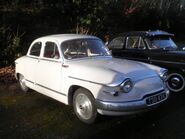
Panhard PL 17
The Panhard PL17 was a motor car made by the French manufacturer Panhard from 1959 until 1965.
Presented on June 29, 1959, as successor to the Panhard Dyna Z, the PL 17 was a development of the older car, but with an even more streamlined body than its predecessor. The four-door saloon was joined in April 1963 by a five-door estate version, followed two months later by a two-door cabriolet.
Model name[]
The model's name was derived from "PL" for "Panhard et Levassor" (the original full name of the company), with the "17" coming from the sum of 5+6+6, being 5 CV (fiscal horses, in the French power rating system) plus 6 for the car's six seats, plus 6 for the car's economy — 6 litres per 100 kilometres (47 mpg-imp; 39 mpg-US).
From 1963 or 1964, the letters PL were dropped; this approximately coincided with the takeover of the passenger car part of the company by Citroën.
Technical specifications[]
The car continued to use the engines of the Dyna Z, both of 851 cc. The standard one gave 42 hp (DIN), the "Tigre" gave 50 hp (DIN). Engines were twin-cylinder air-cooled "boxer" types, mounted unusually by the gearbox at the rear and by the two exhausts at the front! From July 1963 engines decreased in size to 848 cc, but performance went up to 50 hp (37 kW), and 60 hp (45 kW), respectively.
The front wheels were driven through a four-speed gearbox with column shift, and synchromesh on the upper three gears.
The standard car weighed approximately 805 kg (1,775 lb), the Tigre 830 kg (1,830 lb). This light weight combined with the car's streamlining (with a co-efficient of drag said to be Cd 0.26) gave top speeds of 130 kilometres per hour (81 mph) and 145 kilometres per hour (90 mph) for the Tigre.
Suspension at the front by two transverse leaf springs, at the back by three torsion bars each side.
It was possible to remove the back bench to enlarge the already considerable luggage space to 527 litres (18.6 cu ft). This space was available from model year 1964, when the spare wheel was moved from beneath the luggage space to under the bonnet, where it fitted around the air filter. This was possible because the wheels have no centre — that is formed by the finned aluminium brake drums.
A break version was also made in small numbers.
Commercial[]
The Panhard sedans produced after the Citroën take-over were not priced aggressively. In 1962 there were five different versions of the PL17 offering between 42 hp and 50 hp of maximum power and, for the standard sedan bodied versions, priced in France at between 6,990 and 8,240 francs. The similarly sized Simca Aronde came with power outputs ranging between 42 hp and 70 hp, priced between 6,340 and 7,450 francs. The Panhard was a little longer and a little wider, but it could nevertheless be hard to explain why an 850 cc Panhard should cost more than a 1300 cc Simca. Panhard connoisseurs, including many taxi owners, appreciated the PL17s superior road holding and fuel economy, as well as the extra space afforded by the Panhard's greater cabin width. Less pleasing were the awkward gear box, still without synchromesh on the bottom ratio, and the steering which was heavy at low speeds. Performance, especially for the top of the range 50 hp "PL17 Tigre" was helped by the Panhard's lighter body, although the extent of Panhard's weight advantage had been reduced over the previous decade as aluminium had become more expensive and steel panels had been substituted for some of the light metal ones. Pricing issues probably explain why PL17 sales levels were too low to enable the PL17 to approach the volumes of the cannily marketed Aronde.
Competition[]
In 1961 a Panhard PL17 won the Monte Carlo Rally. Evidence that this was no mere fluke came from the PL17s that took second and third places, showing that a lightweight car with a 850 cc engine could be more than a match for heavier cars with more muscular power units.
Demise[]
In 1965 Citroën ceased production of the car. The 24 model carried the name for two years more, and from then only military transport was made under the Panhard name, by the division not owned by Citroën.





